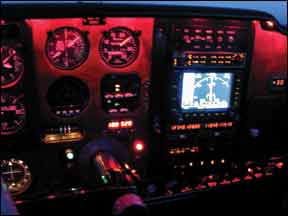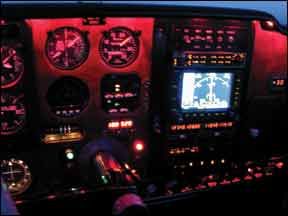Radio silence: that’s what most pilots say got their attention and made them realize they had encountered an in-flight electrical failure. Too bad, because by the time the radios no longer worked, odds are that your electrical system had sucked all the life out of your primary back-up device, your main battery. Many modern personal airplanes come with back-up electrical systems from the factory. But if you fly an airplane equipped as if was the standard just a few years ago, you had better hope you were in day VFR conditions if you found yourself in this pickle. Otherwise, it was going to be a mighty tough night and/or IFR flight without navigation equipment or communication radios (or lights, or power for flaps or landing gear).

288
From my experience, electrical systems have to be an Achilles heel of any light piston aircraft. That said and even among modern aircraft, aircraft designers, in their infinite wisdom, have done anything but standardize the systems. Just because you’ve flown a similar airplane, you can’t presume you understand the procedures for dealing with this airplane’s in-flight electric problem if you haven’t studied its electrical schematic. Without the diagram and the POH to explain how to deal with the problem, you literally will be fumbling around in the dark
The Basics
The electrical system came late to aviation (around the time pilots decided they wanted to be able to fly through clouds instead of having to bail out of perfectly good airplanes every time they got stuck on top of a solid overcast). As one result, typical aircraft electrical systems are independent of engine ignition systems. Magnetos, excited on start up, keep the spark plugs firing. They aren’t asked to do anything else.
Most piston-powered aircraft electrical systems consist of the following major components: alternator(s) or generator, battery (or two), voltage regulator, over voltage relay, battery master switch, master relay, alternator master switch, alternator field breaker and an alternator output breaker. When switched on, electricity, generated by the alternator/generator or batteries, cycles through these breakers and switches without restriction on a normal flight, until something causes the wires to heat up, tripping the circuit at the hot spot and stopping the flow of electrons.
In most personal aircraft, it is the turn coordinator, avionics and internal and external lighting systems, landing gear (if retractable), flaps and anti/de-icing systems that rely on electricity generated through the alternator/generator to function.
The main design difference between the two is an alternator has a rotating electromagnet (rotor) which is energized by the field current (ALT switch) and a stationary coil (stator) delivering the power. The alternator uses diodes to convert the alternating current (AC) to direct current (DC).
The generator, meanwhile, has a stationary permanent magnet with field coils and rotating coils within a fixed magnetic field. The commutator rectifies the alternating voltage/current (AC) to direct voltage/current (DC). It delivers power based on the engine’s rpm, and, in generator-equipped aircraft it is common to see the generator’s “low volts” light illuminate and the battery to discharge while taxiing at low engine rpm. Even alternator-equipped airplanes will see a low-voltage condition at low rpm, especially when using a lot of electrical equipment. You need to know if your airplane has a generator or an alternator: The troubleshooting is different.
The master switch, too, has been the culprit of many electrical failures. Think about it: that switch gets used every single flight. The switch degrades as oxidation of the contacts from internal arcing during use increases the contact resistance. I had one break in a Cessna 182 just after takeoff on an IFR night flight. It caused a total electric failure. We reduced the electrical load and landed immediately.
Choke Points
Voltage regulators maintain the electrical system voltage to a preset level. Consider it the brains of the alternator, because it controls the amount of current that is sourced to the alternator field. Most 14-volt system regulators are set to maintain the electrical system voltage at 13.8 volts, and 28-volt systems maintain 27.8 volts. Solid-state voltage regulators respond faster and more accurately to loads on the electrical system than do the mechanical types, and have the benefit of no moving parts to wear out.
But mechanical (relay-type) voltage regulators almost always fail open circuit, either because a relay coil or a resistor burns out. In rare cases, the relay contacts may weld closed. Open-circuit failures shut the system down—no power is produced. Solid-state voltage regulators, however, short circuit about half the time they fail. Short circuits can cause overvoltage conditions, tripping the relay. That said, the newest solid-state voltage regulators have their own overvoltage sensing system that shuts them down at preset limits.
Alternators on many light aircraft are turned by a drive belt. It can be mounted on the front or rear of the engine. If the belt slips, the alternator doesn’t spin as it should, and the electrons slow down. When the belt fails, the alternator stops altogether. And sometimes when a front-mounted belt fails—as it did for one pilot, according to an ASRS report—the remnants can cause issues. In this case, it slapped against the propeller blades, sounding like playing cards clipped to a bicycle wheel. Front-mounted belts also require propeller removal to replace. Rear-mounted belts don’t, but also can be problematic to align.
Gear-driven alternators, on the other hand, can fail and cough metal into the engine. That’s worth being scared about and justifies a precautionary landing when a gear-driven alternator fails.
Meanwhile, consider circuit breakers and fuses the security or “police” of your electric system. They are essentially switches designed to trip, opening the circuit, stopping the flow of electrons when they sense heat that would jeopardize the wires they protect. Of course, they can fail and overheat, too, and wires break, or melt from engine heat and fuse; any one of these can short out the electrical system in flight.
Coping
So, what do you do when you see your low-voltage light (if you have one), an ALT light, or overvoltage light illuminate in your aircraft? Or worse, how should you react the second you smell that acrid stench of an electrical fire?
Frankly, the first bit of this paragraph should be “red-boxed,” or committed to memory, because it is essentially the same for all light piston aircraft. Most emergency checklists suggest you turn off both sides of the master switch immediately. They go on to suggest you turn off all the avionics and electrically powered systems one by one, and then the buss switches, too. Then, check all the breakers—are they hot?—and reset any cool ones that may have tripped.
If you smell an electrical fire, or see smoke, you’ll need to be ready with a fire extinguisher and prepared to open outside air vents to get rid of the fumes if you use it. You do carry a fire extinguisher, right? Fly with your analog instruments and try to stay on your flight plan, unless you are in visual conditions, in which case you need to stay VFR and land at the nearest airport to troubleshoot on the ground.
The FAA knows that’s what you’ll do even if you are on an IFR flightplan and can’t tell them by squawking 7600, via a handheld back-up radio or a telephone.
If your problem has progressed to a fire, land as soon as practical, even if off-airport. Trying to make an airport instead of the nearest flat area with an in-flight fire isn’t smart. It can quickly incapacitate you.
Don’t tempt fate by resetting the switches to see what you’ve got left in the system. Just fire up your backups (you did bring your handheld nav/com and GPS, right?) and be ready to perform an instrument approach with your backup GPS and remaining instrumentation. And know your no-radio operations, because handhelds without external antenna are notoriously bad transmitters in the cockpit. For more on in-cockpit communications issues, see the article beginning on page 12.
When the problem isn’t a fire, the standby alternator, followed by the main battery, followed by any secondary battery, is your backup electrical system, but know this: Any batteries are only as good as the last charge they took. And if you are going to be limping home on batteries, reduce your electrical load. Turn off lights, your transponder, EFIS if you can, and all but one radio (and even then tell ATC you won’t be transmitting because that takes far more energy than receiving). The average battery in a single-engine piston airplane is a 35-amphour battery, meaning you get 35 amps for one hour. or one amp for 35 hours—that’s how batteries work.
Standby alternators are good for limping home, too (and can add VFR-only dispatch reliability). They typically put out less power than primary alternators in single-engine aircraft, but are often full-size alternators in twins (because, with two engines, they can be).
Now, Here’s the Good News
Modern, all-electric, glass-panel aircraft typically are set up for electrical emergencies with both standby alternators and backup batteries. Many also come with an emergency bus, powering a nav/comm and the transponder, but that’s about it. The theory is you have limited battery life remaining and must conserve. The emergency bus in my airplane powers a Garmin 300XL GPS navigator/com radio, the autopilot, pitot heat and pitch trim. I can shoot an approach in IFR, communicate with ATC, avoid an iced-up pitot-static system and keep the airplane flying while I troubleshoot. I have a separate switch to power the e-bus, so I can use it on the ground to input flightplan info and call for clearances without wearing out my master switch or exciting the alternator. I’ve used it successfully with the standby alternator after my main alternator failed in busy Class B airspace. The load is low enough that the standby alternator had plenty of power for it, and I had plenty of electricity for operating flaps and trim for my landing.
In the end, an electrical failure, partial or total, is no more challenging than pilots make it. You’ve got to prevent the catastrophe, isolate the problem and operate with what you’ve got left to get yourself safely on the ground where repairs can be made. That said, it’s clear: The more you understand the specific electrical system you fly behind, the more capable you’ll be of handling its idiosyncrasies.
Amy Laboda is a freelance writer, CFII-MEI and a National Lead FAAst Team representative. She holds an ATP and flies two experimental aircraft: one that’s sweet and slow and one that’s pretty and fast.




